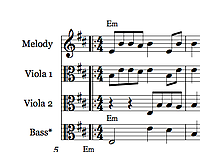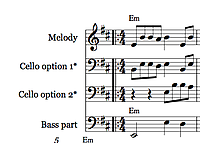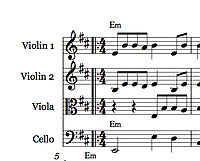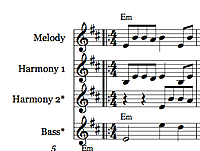Home » Sheet Music » Folk Tune Harmony Arrangements » How to Use
How to Use My Traditional Tune Harmony Arrangements in Different Instrumental Groups
Update 20-10-2015 : This post references my Irish tunes sheet music bundle, but in fact applies to all of the four part harmony arrangements on this website . The arrangements proved very popular, so I’m adding some more. Click here to buy the sheet music described in this blog post.
My harmony arrangements of traditional tunes were originally created as a way for violists to play harmonies along with violinists. However, as I was writing them, it became clear that they’d fit not just on viola, but a variety of other instruments – and groups of instruments – as well.
Rather than make a lot of separate downloads (e.g “cello and violin”, “viola and violin”, “two violins and viola”) I’ve included all the different versions in the one package, which includes the sheet music for a wide range of possibilities in terms of ensemble. While this means it’s flexible – anyone who buys the sheet music can re-use it with different groups of musicians – some people find it confusing and I’ve received a few emails asking whether it will definitely work with their particular group of instruments, and if so, how.
I’m writing this post to explain how to use my folk arrangements in different duos, trios, quartets and larger groups.
How it Works
For each traditional tune, I’ve written three different harmony parts.
I’ve made several different scores of these harmony parts for each piece: one for standard string quartet, one with all the harmonies in alto clef, one with all the harmonies in treble clef, and one with all the harmonies in bass clef.
Click on the thumbnails below for examples of each version.
Any one of the three harmony parts works as a standalone harmony for the tune, i.e. to be played in a duet. If the tune is to be played multiple times through by a duo, the person playing the harmony can play one harmony the first time, another the second, etc. to form a more complex arrangement.
Alternatively, they could just choose their favourite harmony part and just play that one.
This allows flexibility in terms of using the arrangements with different levels of ability – more advanced players may like to learn multiple parts; beginners might prefer to choose the part they find easiest.
As well as this, multiple harmony parts can be played at the same time.
This means a larger group such as a trio or quartet can use them.
The harmony parts can be used as building blocks to create a long or more complex arrangement, playing the tune more than once through, with different people taking different parts each time through the tune.
They can also, of course, be used as a simple arrangement for a larger group, in which everyone sticks on one part.
Instructions for Specific Groups of Instruments
Click on any of the ensemble types below to find out about that one in particular – or scroll down to read through all of them.
You can download the sheet music for all ensembles from here .
Quartets:
Two violins, viola and cello
Three violins and cello
Two violins, two cellos
One violin, two violas and cello
One violin and three violas
One violin, one viola, two cellos
Two violins, two violas
Three violins, one viola
Trios:
Violin, viola and cello
Two violins and cello
Violin and two violas
Violin and two cellos
Three violins
Duets:
Two violins
Violin and viola
Violin and cello
——
Two violins, viola and cello
For a standard string quartet, all players can read from the “string quartet” version of the sheet music for each tune for a simple arrangement.
For a more complex arrangement in which players want to try out different harmony parts, each player should use the version of the music which presents the harmony parts in the right clef for their instrument. The violins should both use the version that is all treble clef; the viola all alto clef; the cello all bass clef. It is then up to the players to decide who plays which part when.
Three violins and cello
For a simple arrangement, this can be treated like a standard string quartet but with the viola replaced by a third violin. Violins 1 and 2, and the cellist, can read from the sheet music for string quartet. The third violin should be given the music with all the harmony parts in treble clef, and should play the third line down (which is the same line as the viola part in the string quartet version, but may be in a different octave).
For a more complex arrangement in which players switch between different harmonies, give each player the version with all the harmonies written in the right clef for their instrument. The violins should both use the version that is all treble clef; the cello all bass clef. It is then up to the players to decide who plays which part when.
Two violins, two cellos
Give both violins the sheet music with all the harmony parts in treble clef. Give both cellos the music with all harmony parts in bass clef.
For a simple arrangement, violin 1 plays the melody, violin 2 plays the second line, cello 1 plays the third line, and cello 2 plays the bottom line.
For a more complex arrangement, using the same versions of the sheet music, players can decide between them who will play which part at which time.
Two violins, two violas
Give both violins the sheet music with all the harmony parts in treble clef. Give both violas the music with all harmony parts in alto clef.
For a simple arrangement, violin 1 plays the melody, violin 2 plays the second line, viola 1 plays the third line, and viola 2 plays the bottom line.
For a more complex arrangement, using the same versions of the sheet music, players can decide between them who will play which part at which time.
Three violins, one viola
Give all violins the sheet music with all the harmony parts in treble clef. Give the viola the music with all harmony parts in alto clef.
For a simple arrangement, violin 1 plays the melody, violin 2 plays the second line, violin 3 plays the third line, and the viola plays the bottom line.
For a more complex arrangement, using the same versions of the sheet music, players can decide between them who will play which part at which time.
One violin, two violas and cello
Give the violinist the sheet music with all the harmony parts in treble clef. Give both violist the sheet music with all harmony parts in alto clef. Give the cellist the music with all harmony parts in bass clef.
For a simple arrangement, the violinist plays the top line, viola 1 the second line, viola 2 the third line, and the cello the 4th line.
For a more complex arrangement, using the same versions of the sheet music, players can decide between them who will play which part at which time.
One violin and three violas
All players can read from the version of the sheet music with all the harmonies written in alto clef.
For a simple arrangement, the violin plays the top line, and violas 1,2 and 3 take the second, third and fourth lines.
For a more complex arrangement, using the same version of the sheet music, the players can decide between them who will play which part at which time.
Violin, viola and cello
Give each player the sheet music with all the harmony parts written in the clef that their instrument uses. (Treble for violin, alto for viola, bass for cello.)
For a simple arrangement, the violin plays the top line, the cello plays the bottom line, and the viola can choose whether to play line 2 or line 3.
For a more complex arrangement, the viola and cello can play any of the different harmony parts – it is up to the players to decide when they play which part.
Two violins and cello
Give each player the sheet music with all the harmony parts written in the clef that their instrument uses. (Treble for violin, bass for cello.)
For a simple arrangement, the 1st violin plays the top line, the cello plays the bottom line, and the 2nd violin can choose whether to play line 2 or line 3.
For a more complex arrangement, the musicians can play any of the different harmony parts to accompany the melody – it is up to the players to decide when they play which part, which violinist plays the melody which time, etc.
Violin and two violas
Give each player the sheet music with all the harmony parts written in the clef that their instrument uses. (Treble for violin, alto for viola.)
For a simple arrangement, the violin plays the top line, and the two violas can take one each of any of the other lines.
For a more complex arrangement, the violas can play any of the different harmony parts – it is up to the players to decide when they play which part.
Violin and two cellos
Give each player the sheet music with all the harmony parts written in the clef that their instrument uses. (Treble for violin, bass for cello.)
For a simple arrangement, the violin plays the top line, and the two cellos can take one each of any of the other lines.
For a more complex arrangement, the cellos can play any of the different harmony parts – it is up to the players to decide when they play which part.
Violin trio
Give all players the version of the sheet music with all harmony parts in treble clef.
For a simple arrangement, one player plays the top line, and the other two play whichever of the harmony parts they like best.
For a more complex arrangement, the players can decide between themselves who plays which part when.
Two violins
Give both players the version of the sheet music with all harmony parts in treble clef.
For a simple arrangement, one player plays the top line, and the other plays plays whichever of the harmony parts they like best.
For a more complex arrangement, the players can decide between themselves who plays which part when.
NEW: I have now also made a dedicated collection of 40 tunes as fiddle duet sheet music. If you're only looking for violin duets and don't intend to play in a larger group, this offers substantially more music for the same price, so is a better option!
Violin and viola duet
Give both players the version of the sheet music with all harmony parts in alto clef. The violinist will play the melody, which is written in treble clef.
For a simple arrangement, the violinist plays the top line and the violist plays whichever harmony part they like the best.
For a more complex arrangement with the tune played several times through, the viola player can choose a different harmony part at different times, e.g. the second line for the first time through the tune, the third line for the second time, or switching between different harmonies on the repeats, etc.
Violin and cello duet
Give both players the version of the sheet music with all harmony parts in bass clef. The violinist will play the melody, which is written in treble clef.
For a simple arrangement, the violinist plays the top line and the cellist plays whichever harmony part they like the best.
For a more complex arrangement with the tune played several times through, the cello player can choose a different harmony part at different times, e.g. the second line for the first time through the tune, the third line for the second time, or switching between different harmonies on the repeats, etc.




